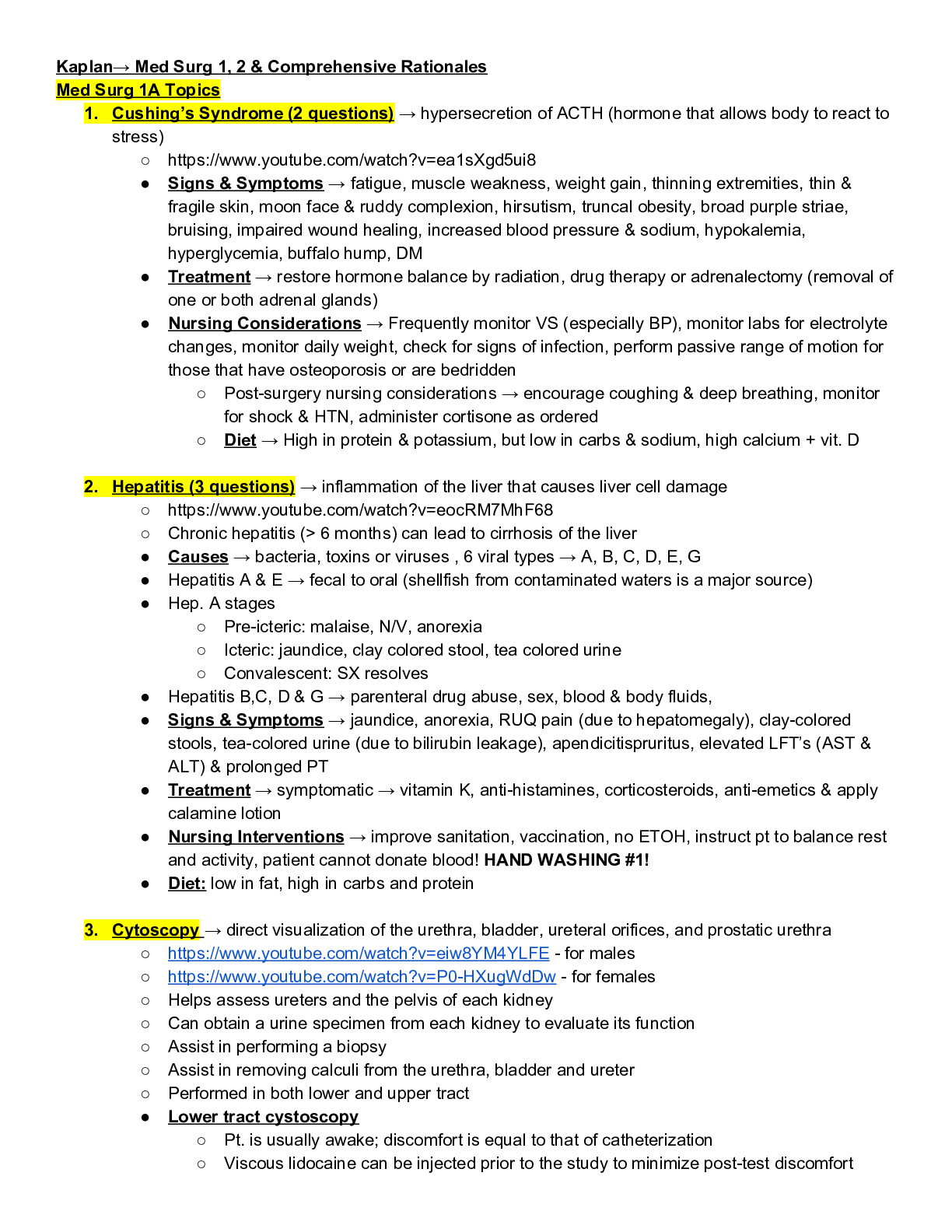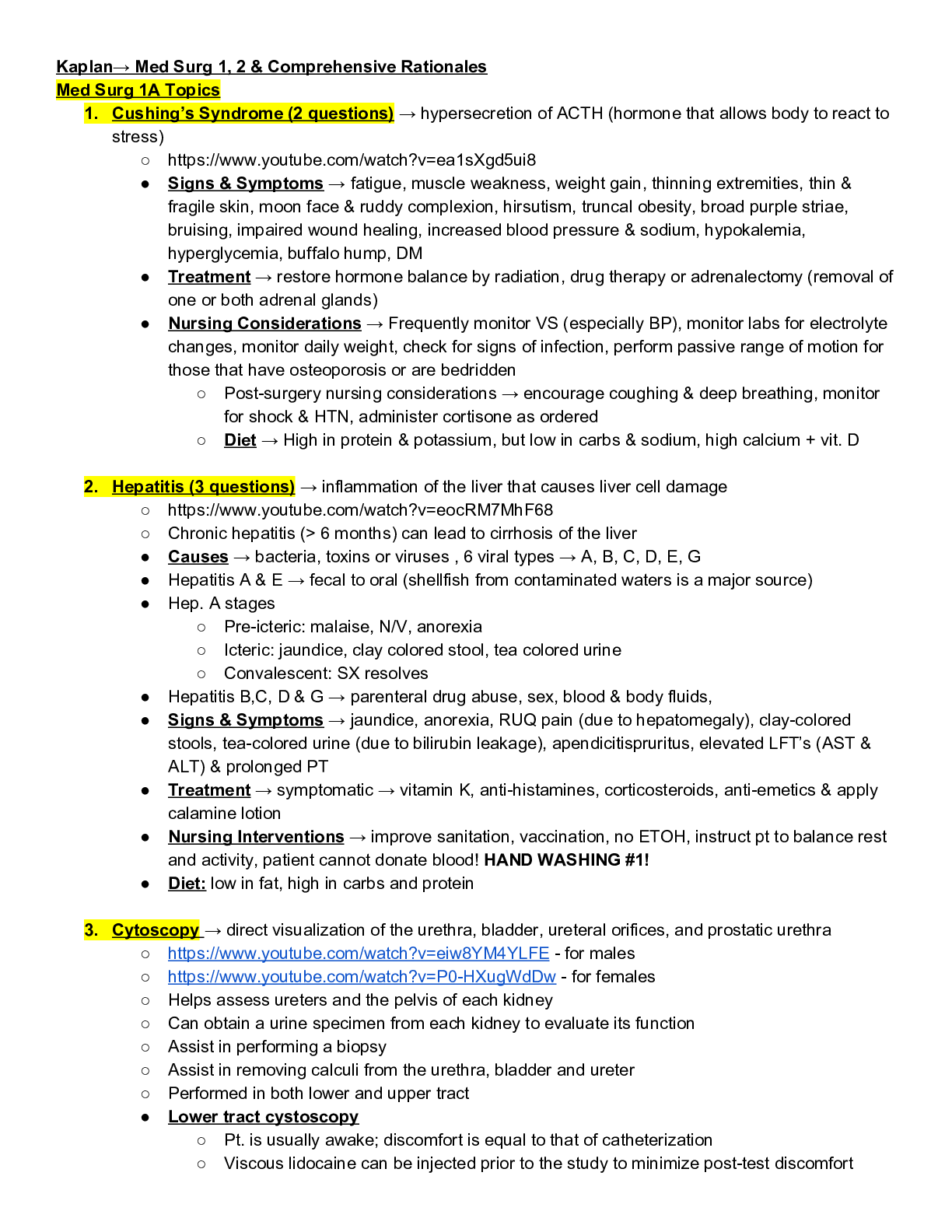Med Surg 1A Topics 1. Cushing’s Syndrome (2 questions) → hypersecretion of ACTH (hormone that allows body to react to stress) ○ https://www.youtube.com/watch?v=ea1sXgd5ui8 ● Signs & Symptoms → fatigue, muscle weakness, weight gain, thinning extremities, thin & fragile skin, moon face & ruddy complexion, hirsutism, truncal obesity, broad purple striae, bruising, impaired wound healing, increased blood pressure & sodium, hypokalemia, hyperglycemia, buffalo hump, DM ● Treatment → restore hormone balance by radiation, drug therapy or adrenalectomy (removal of one or both adrenal glands) ● Nursing Considerations → Frequently monitor VS (especially BP), monitor labs for electrolyte changes, monitor daily weight, check for signs of infection, perform passive range of motion for those that have osteoporosis or are bedridden ○ Post-surgery nursing considerations → encourage coughing & deep breathing, monitor for shock & HTN, administer cortisone as ordered ○ Diet → High in protein & potassium, but low in carbs & sodium, high calcium + vit. D 2. Hepatitis (3 questions) → inflammation of the liver that causes liver cell damage ○ https://www.youtube.com/watch?v=eocRM7MhF68 ○ Chronic hepatitis (> 6 months) can lead to cirrhosis of the liver ● Causes → bacteria, toxins or viruses , 6 viral types → A, B, C, D, E, G ● Hepatitis A & E → fecal to oral (shellfish from contaminated waters is a major source) ● Hep. A stages ○ Pre-icteric: malaise, N/V, anorexia ○ Icteric: jaundice, clay colored stool, tea colored urine ○ Convalescent: SX resolves ● Hepatitis B,C, D & G → parenteral drug abuse, sex, blood & body fluids, ● Signs & Symptoms → jaundice, anorexia, RUQ pain (due to hepatomegaly), clay-colored stools, tea-colored urine (due to bilirubin leakage), apendicitispruritus, elevated LFT’s (AST & ALT) & prolonged PT ● Treatment → symptomatic → vitamin K, anti-histamines, corticosteroids, anti-emetics & apply calamine lotion ● Nursing Interventions → improve sanitation, vaccination, no ETOH, instruct pt to balance rest and activity, patient cannot donate blood! HAND WASHING #1! ● Diet: low in fat, high in carbs and protein 3. Cytoscopy → direct visualization of the urethra, bladder, ureteral orifices, and prostatic urethra ○ https://www.youtube.com/watch?v=eiw8YM4YLFE - for males ○ https://www.youtube.com/watch?v=P0-HXugWdDw - for females ○ Helps assess ureters and the pelvis of each kidney ○ Can obtain a urine specimen from each kidney to evaluate its function ○ Assist in performing a biopsy ○ Assist in removing calculi from the urethra, bladder and ureter ○ Performed in both lower and upper tract ● Lower tract cystoscopy ○ Pt. is usually awake; discomfort is equal to that of catheterization ○ Viscous lidocaine can be injected prior to the study to minimize post-test discomfort
○ General anesthesia is usually administered ● Upper Tract cystoscopy ○ Pt. usually kept NPO for several hours before test ○ A sedative may be administered ○ Pt. can expect some burning on voiding, blood in urine, urinary frequency ○ Heat applications are helpful in relieving pain and relaxing muscles ● Nursing Care → monitor pt. with prostatic hyperplasia (enlarged prostate that can cause urine difficulty) for urine retention, suggest warm sitz baths and antispasmodic meds, monitor for s/s of UTI 4. Diabetes Mellitus (4 questions) → know setting priorities → Condition is characterized by a high level of glucose in the body ○ Signs & Symptoms → THE POLY’s (polyuria,polydipsia, polyphagia), weakness, dizziness, fatigue i. In Children → those above + enuresis (bed-wetting), unusual fatigue & irritability ○ Type 1 → beta cells in pancreas are destroyed and produce no insulin i. Treatment → insulin injections, continuous infusion via pump & diet control ○ Type 2 → beta cells in pancreas secrete insulin, but the body is resistant to its effects i. Treatment → insulin, oral hypoglycemic injections & diet control ○ Diet Management → monitor total calories, carbs & timing of food ○ Diet Intake → meals with complex carbs, ↓ fat, ↑ fiber, some protein i. Time meals with peak effect of insulin ii. Provide extra snacks for unplanned physical activity iii. Substitute soft foods 6-8 times per day if you cannot stick with the usual meal plan iv. If vomiting, diarrhea or fever persist take in some liquids like ½ cup coke, juice, broth or 1 cup of gatorade to maintain caloric intake every ½ hour or hour v. Report nausea, vomiting & diarrhea to HCp → extreme fluid loss = dangerous vi. Unable to retain fluids = hospitalization to prevent DKA ○ Patient Teachings → lose weight if obese, oral hypoglycemic agents, maintain healthy weight, s/s of hypoglycemia & hyperglycemia, self-monitoring of glucose, skin/foot care, importance of exercise ○ “Sick Day” Rules → guidelines for managing diabetes when ill → aimed at preventing DKA i. Take insulin or hypoglycemic agents as usual ii. Test blood glucose & urine ketones every 3-4 hrs → report elevated levels to MD iii. If you take insulin, you may need supplemental doses every 3-4 hours ○ Dawn Phenomena → early morning glucose levels are elevated caused by nocturnal release of growth hormone ○ Somogyi Effect → fall in blood glucose during the night with ↑ morning glucose levels → caused by 5. Thermal Injury (4 questions) ● First degree (Superficial partial-thickness)→ epidermis affected (destroyed or injured); painful, red, dry, min. or no edema ● Second degree (Deep partial-thickness) → epidermis and part of dermis affected; painful, red, exudes fluid, edema, blistered ● Third degree → Total destruction of epidermis, entire dermis, and in some cases subcutaneous tissue, muscle or bone; painless, varied color (white, red, black, brown or charred), dry, leathery,
edema, symptoms of shock, probable hematuria (RBC in urine) and hemolysis (break down of RBC’s) ● First responder interventions: ensure safety of yourself, extinguish flames, cool burn by briefly applying cool water to burn and clothing covering burn, remove other clothing, cover wound to prevent contamination, irrigate chemical burns, asses ABC’s ● Treatment: grafts → use of skin or other materials to cover burned areas ● Nursing Care: IV Lactated Ringers, plasma; F/C to monitor I/O (should be 30ml/hr), check for s/s of fluid overload vs. dehydration, monitor BP, v/s, weight, electrolytes, wound care at least once a day (administer pain meds 30min before wound care), sterile technique, tetanus prophylaxis; high caloric, high-carb, high-protein diet, may require parenteral nutrition; estimate TBSA (total body surface area) with the Rule off 6. Herpes Zoster (Shingles) → Acute infectious viral disease that is reactive of chickenpox virus, presents as unilateral, painful rash, group of vesicles on an erythematous base along a dermatome ○ Treatment → calamine lotion to soothe itching & pain, Acyclovir, corticosteroids to reduce inflammation, vaccination to prevent or modify the disease course ● Nursing considerations: minimize pain & prevent complications, analgesics, apply compresses (wet dressings to skin lesions & cold compresses to ruptured vesicles), administer systemic corticosteroids to diminish severity, prevent spread- contagious to anyone who has not had chickenpox or is immunocompromised 7. Hernia (2 questions → know Umbilical Hernia) → protrusion of intestines through a weakness in the umbilical ring, muscle & fascia Types of Hernias ● https://www.youtube.com/watch?v=3wUrJGDgGO4 ● Umbilical → Hernia occurring at the naval ; more common in women who are obese or multiparous ○ S/S → bulging protrusion at the umbilicus → pain, discomfort at site ○ Treatment → Size of fascial ring less than 2 cm = none; larger = surgery → laparascope ○ Nursing Care → do not use a belly band or tape a silver dollar to the area, keep pressure dressing in place until sutures are healed, sponge-bath child until the dressing is removed & keep diapers folded below the dressing ● Hiatal → opening in diaphragm through which esophagus passes ○ S/S: heartburn, full after meals, GI bleed and N/V (severe) ● Inguinal → Protrusion of the hernia sac containing the intestine of the inguinal opening 8. Incentive Spirometer → Breathing device used to maximize lung expansion by opening closed alveoli and mobilize secretions → facilitates tissue oxygenation!, prevents atelectasis ● Nursing considerations: instruct client to breath in and exhale normally, seal lips around mouthpiece, inhale slowly and deeply, holding breath for at least 3 seconds while keeping ball or cylinder elevate, exhale, take several normal breaths and rep
Read More


